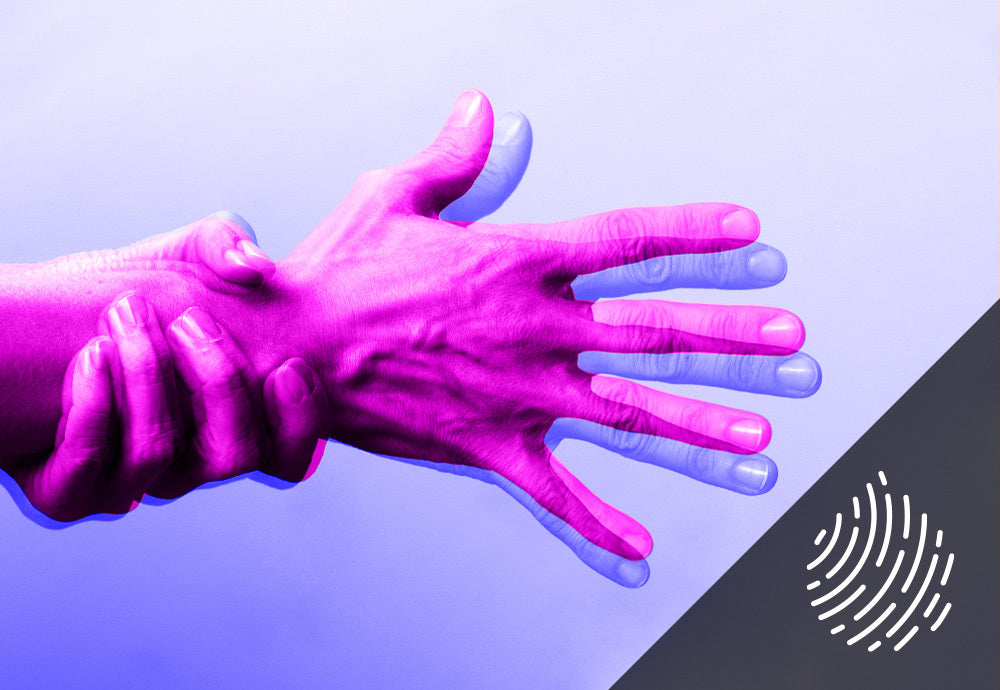Your Cart is Empty
FREE SHIPPING ON ORDERS $70+ | SATISFACTION GUARANTEED
We live in a world where technology surrounds us. From the moment we wake to our phone alarms to cozying up on the couch for some nighttime shows on our streaming service — it's almost impossible to escape technological devices and their many uses.
The digital age has allowed us to create, innovate, and adapt in ways we never thought possible.
But with all of these wonderful benefits comes some not-so-wonderful side effects:
You've mastered the art of running a productive web meeting, but has your tech-saturated lifestyle become a pain in the neck?
Researchers are finding that regular technology use (like working on a computer) increases your likelihood of developing pain disorders in the neck, back, and shoulders.(1)
Over time, long periods of sitting, staring at a screen, and poor posture can lead to these symptoms:
You — yes you — reading this right now. Are you reading this blog post on your phone? If so, you likely have your head craning forward, shoulders tensed up, and back rounded. Sound familiar?
You're sitting in the classic tech neck, also sometimes called text neck, position. Tech neck is the term used to describe pain in your upper back, shoulders, and neck due to long periods of time spent looking down at a screen. As you can deduce — this is a common enough phenomenon to have earned its own clever little name.
Over the long-term, a little bit of neck stiffness can turn into debilitating pain that radiates down your shoulders and back. You're at greater risk of the pain spreading to different areas of your body. And later needing more extensive treatment.
If you have or are at risk for arthritis, you may experience a worsening of symptoms. Arthritis is a condition in which long-term strain on the joints can lead to wearing away of the cartilage around the cervical spine, causing the bones to rub against each other. This causes the joints to get inflamed, causing pain. While technology doesn’t directly cause arthritis, it can make it worse.
Unfortunately, these pain disorders are common nowadays — but it doesn't have to be this way!
It's unrealistic to expect you to quit technology entirely. Plus, who would want to? Those cat videos aren't gonna watch themselves. Meow.
So, instead of giving up the computer or tablet completely, here are some ways to avoid and alleviate those unpleasant side effects of too much tech use.
Plain and simple, try to cut some tech-time out of your day. The average person spends over four hours a day on a mobile phone.(2) Those hours of looking down on your phone add up and can have lasting impacts on your head and neck. So try and find ways to reduce the amount of time you spend on your digital devices.
When it's impossible to ignore your phone, try to bring your screen to your eye level. This way, you avoid looking down — one of the biggest contributors to neck issues.
Take regular breaks to rest your eyes, neck, and back.
When you're at work, practice the 20-20-20 rule to prevent eye strain. In the 20-20-20 rule, every 20 minutes you spend looking at a screen, you look away at something 20 feet away for 20 seconds.
This helps your eyes because when you stare at screens, you tend to blink a lot less. This leads to strain, discomfort and dry eyes.(3) Giving those peepers a rest will help prevent eye fatigue.
If you’re at a desk, the moment you start to feel any discomfort or pain in the body, it’s a sign to stop and adjust. Check in on your posture. Stretch out your neck and body. Aim to take at minimum, five minutes of a break every hour of working on the computer.
People who exercise regularly are less likely to develop body aches and pains.
Be sure to get in regular exercise to strengthen your back and core. Your core supports your spine, so strong abs = strong back.
Even better, get some fresh air and exercise by going on a walk break. Being in nature is shown to improve mood and lower stress levels. In fact, spending just a few minutes in nature can decrease stress and improve your ability to focus.(4) The more stressed you are, the more likely you are to hold that tension in your shoulders and worsen your pains.
So take a break from the phone and go for a walk in a park. You'll be refreshed, having stretched out your muscles and you’ll find greater focus at work. Double benefits.
If you need a quicker hit, even doing periodic “chair yoga” or “cubical calisthenics” for a couple of mins can be a helpful F5 (i.e., refresh) for your body.
Working from home can be particularly bad for neck straining. If you're sitting on the sofa or in bed with a laptop, you increase your chances of neck pain because you extend your neck to look down.
To avoid this, adjust your laptop or monitor to be eye level. Instead of looking down on your screen, look forward with your neck in a neutral position.
Also consider your work chair. Does your chair help you sit up straight in a neutral position? Your office chair should help you sit comfortably in an upright position, with your feet flat on the floor and the back of the chair supporting your lower back.
At home you can use a small pillow or towel behind your lower back for support. And set a stool on the floor if your feet don't touch the ground.
Small shifts to your posture will help avoid long-term aches and pains.
CBD products — like CBD softgels, CBD creams, and CBD oil — are widely used to relieve muscle soreness and joint pain, as well as headaches.
Cannabidiol (the star ingredient in CBD oil), doesn't have any psychoactive effects like THC does. Instead, people love CBD for it's anxiety-busting and pain-relieving properties.
Research shows that CBD may help reduce the inflammation and pain associated with many pain disorders, like arthritis.(5) Studies have also shown that individuals who substituted opioid and other pain medications with CBD, reported larger improvements in pain than those who did not.(6)
Plus, unlike some pain relievers, CBD is non-addictive. It's a natural way to help relieve tech-related aches and pains, through the power of plants.
Some tips on choosing CBD products:
For an in depth rundown on using CBD to relieve pain, check out our article CBD For Everyday Aches & Pains.
From laptops to tablets, televisions to mobile phones — technology is an integral part of our daily lives. But, if we're not careful, extended use of these digital devices can lead to pain disorders that may worsen over time.
There are many ways to relieve aches and pains related to technology use. Incorporating these techniques into your daily routine can help you avoid long-term or more severe probs. Some of the best methods of mitigating issues include:
Pure Craft offers a variety of CBD products that can help support on-the-spot and day-to-day pain management.
References

The cannabis compound CBD has been popping up in Parkinson’s disease (PD) therapy and prevention conversations, propelled by success stories from p...
Read More
CBD is one of the most popular supplements on the market today. But you're a savvy consumer. You know just because something is popular doesn’t mea...
Read More
You know delta-8 as "weed-lite" or the "chillest of the cannabinoids." But what about all the potential health benefits of this unique compound? Wh...
Read More